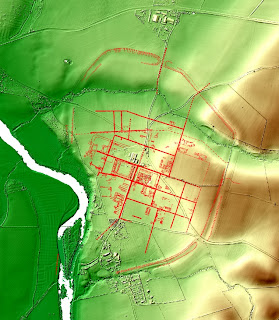Next in our tour of Roman sites (once more courtesy of Environment Agency lidar): Wroxeter, Viroconium. The overlay of the layout of the town is from Wacher's Towns of Roman Britain, so not the most up-to-date plan by any means, but it will do to be going on with.
Thursday, 30 May 2013
Wednesday, 29 May 2013
Durobrivae - Credenhill - Kenchester
Three lidar images at the same scale: Durobrivae, Credenhill hill fort in Herfordshire and the site of the Roman town at Kenchester a few kilometres to the south. Data courtesy of the Environment Agency again.
Durobrivae lidar
Environment Agency lidar data is now freely available for non-commercial use, so I have been setting about making use of it (after jumping through a few hoops to establish my non-commercial credentials in this instance). Roman town sites are the order of the day, particularly green-field sites, as in this instance at Chesterton/Water Newton (Durobrivae). The site of the town and its defences are very evident in the survey, with the route of Ermine Street through the town to the river crossing and beyond especially clear. Dropping the cropmark plot over the top goes to show how much lidar survey can aid understanding of landscape setting (quite apart from its mapping of earthwork features). The site of the palatial complex at Castor lies towards the northern edge of the map (to be added later).
Subscribe to:
Comments (Atom)



